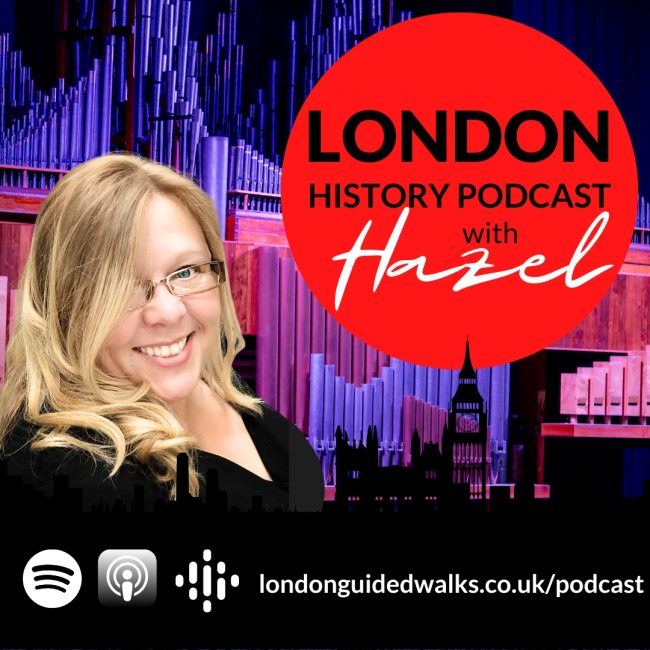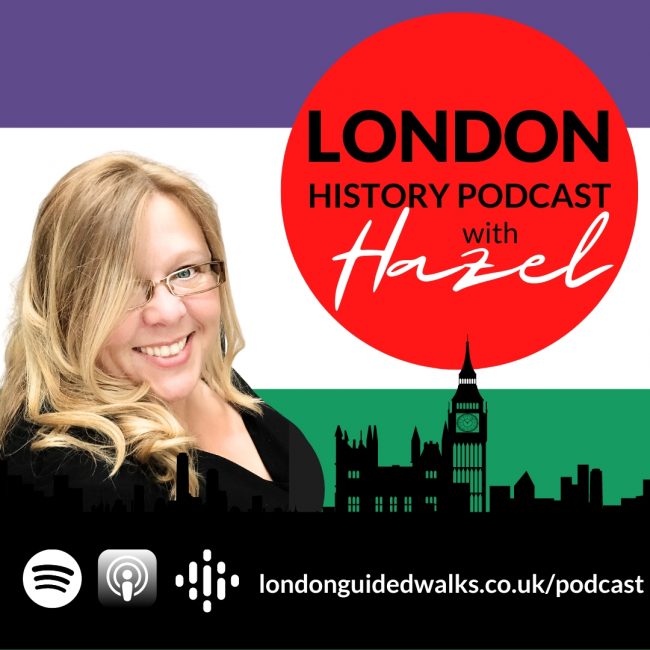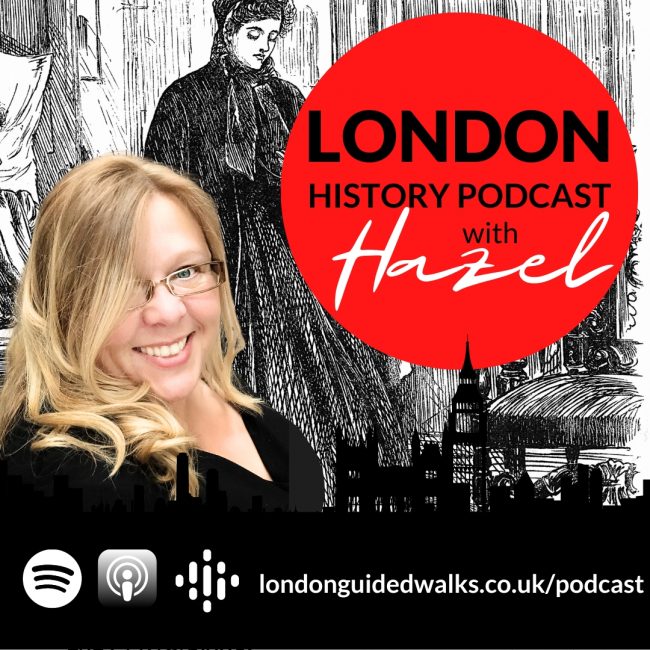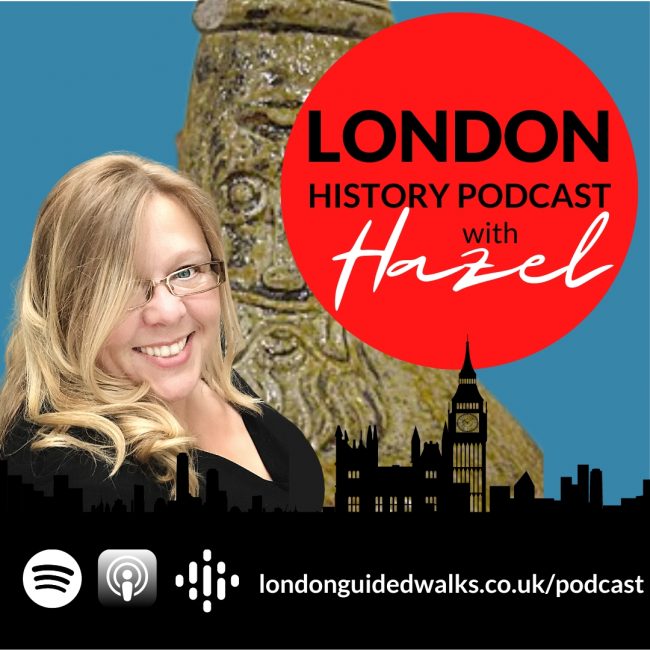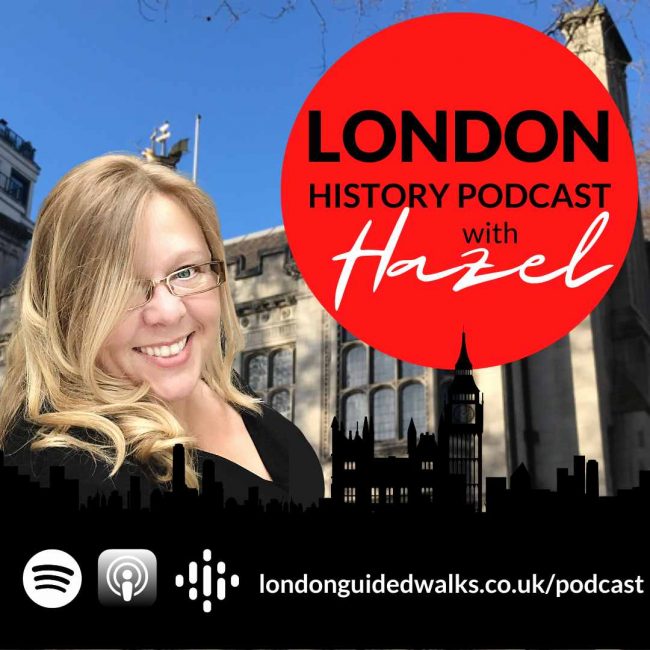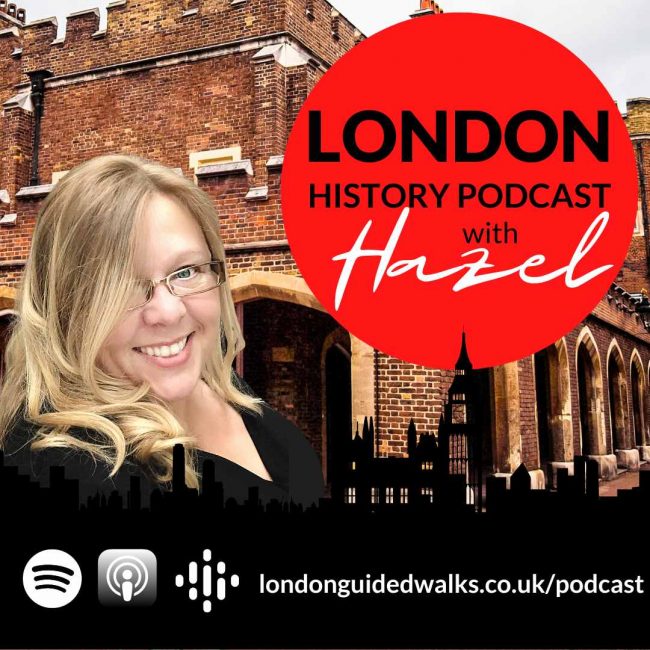Related Blog Posts:
Related Podcast:
The Monument to the Great Fire of London
Show Notes:
 Hazel: Hello and welcome to London Guided Walks London History podcast. In the coming episodes, we will be sharing our love and passion for London, its people, places and history in an espresso shot with a splash of personality. For those of you who don’t know me, I am Hazel Baker, founder of London Guided Walks, providing guided walks and private tours to Londoners and visitors alike.
Hazel: Hello and welcome to London Guided Walks London History podcast. In the coming episodes, we will be sharing our love and passion for London, its people, places and history in an espresso shot with a splash of personality. For those of you who don’t know me, I am Hazel Baker, founder of London Guided Walks, providing guided walks and private tours to Londoners and visitors alike.
The great fire of London destroyed four fifths of the city. The monument on Fish Street Hill is a Memorial to the great fire of 1666, and to those who rebuilt the city without rock and roll. Ian is one of our tour guides who delivers our great fire of London walk and is with me today to discuss the monument in more detail. Welcome.

Ian: Thank you.
Hazel: The monument is the tallest isolated stone column in the world. It took six years to build to the difficulty of getting a sufficient quantity of Portland stone or the required dimensions. This caused the King to issue a proclamation on the 4th of May, 1669 forbidding any person to transport stone from the of Portland without Christopher Wren’s permission.
Ian: The monument stands just north of London bridge on Fish Street Hill, and in some ways it’s one of London’s best known monuments after all, there’s a tube station named after it, and it attracts a large number of visitors who can often see queuing up to get inside to climb up to the top of it. But I think that it’s a rather an under-appreciated building.
I think there’s quite a lot that’s very interesting about the monument. People visiting to it, visiting it aren’t necessarily aware of, and I thought I’d begin by providing a description of it. For people who aren’t familiar with it. It’s a Doric column. Doric is the simplest of the three Greek orders of architecture and it stands 202 feet high, and that 202 feet high is quite important.
I’ll come back to that in a second, and on top of it is a flaming urn to commemorate the. The fire. The monument itself was built between 1671 and 1777 to commemorate the great fire of London of 1666 which ended up destroying a full four fifths of the city of London. Now saying that it was 202 feet tall.
The reason it is precisely that height is that if you were to lay it on its side in roughly an easterly direction. You would end up at a spot on pudding lane, which is where foreigner’s bakery was, and this is the precise spot where the great fire broke out in a 1666 in September. Might add in passing that the, the name pudding lane probably doesn’t mean putting in the modern sense, but comes from a much older.
Worked for entrails around the area at the top in East Cheap. There were lots of butchers and the pudding probably referred to the end trails that were left hanging around quite often on the streets to be washed away. The monument is built as a reminder to commemorate the Great Fire of London. It’s built as a column and at its base it has a huge pedestal.
The pedestal is probably about 20 feet high, and on three sides of the pedestal are pieces of writing in Latin. And I think this is one of the things that goes unremarked date by visitors, partly because so few of us read Latin. It’s interesting asking yourself why they did that. The inscription in Latin in the first place because then as now only a minority of people would read Latin.
Obviously back then in the 17th century, Latin was a more important language. It was something that in theory, if you were a gentleman you were familiar with, it was a sign of your education and you might say, well, they were only really concerned at the upper echelons of society in talking to themselves, and therefore Latin was the natural language for this.
However, I think he goes a bit deeper than that, and the pedestal has three times a bit, have Latin writing on it, and the fourth, which phases towards the West has a sculpture by Caius Gabriel Cibber depicting the fire of London and opposite the sculpture. That’s just to say on the Eastern side is a list of the men who were Lord mayors at the time of the, through through the period of the construction at the monument.
And they are flatteringly known as prefecti. So the, the word law translated into this rather grand Latin sounding word prefect. And then the other sides, the, the Northern Southern side have full attack. So the Northern side of the monument has a text in Latin describing the progress of the fire. And then the other side, the Southern side has a list of all of the things that Charles II, and to a lesser extent, his brother James did to rebuild London.
It claims that they, the old city of wood was rebuilt in stone with new broad streets designed on a geometrical and pleasing basis. This is a huge exaggeration about what they actually achieved, but it’s interesting and it comes back to the Latin, and I think the significance of the Latin is that it is designed to awake in the minds of the people who are reading it the res gestae of Augusta so Augusta is the first of the Roman emperors. And one of his major acts propaganda is to produce his res gestae, which means literally means things undertaken things done, and this is a huge piece of writing, huge piece of a hippography that was ordered to be set up in all the big cities of the empire and there was one version of it for example, on Augustus’s mausoleum in Rome. And one large part of this achievements of Augustus, which takes up a huge amount of text concerns. His rebuilding of Rome, one of the claims of Augustus at the end of his life was that he found at Rome, a city built in brick. And when he finished with it, it was a city built in marble.
And I think that the Latin inscriptions are trying to rather draw a parallel between Charles II and Augustus,, because Charles is rebuilding London in the way that Augustus, rebuilt Rome. And the comparison is a flat flattering one because Augustus is this great figure from Roman history, but it’s also important because Augustus is the first of the emperors, and he claims that the benefit of his rule is to bring peace to Rome after the civil war. And again, this is obviously a very close, convenient parallel for Charles. He has been restored to the throne in 1660 after a period of civil war. After Republic and so he’s advertising the benefits of his rule that he like Augustus has, has brought peace after a period of turmoil and it could well be as well that Charles always had ambitions to be fairly or authoritarian and like Augustus. he is trying to say that it’s worth giving up. Some of the restrictions on the powers of a print in order to have peace and stability. The sculpture then brings this theme further to life. The theme is the sculpture is on the Western side of the monument and it shows Charles flanked by his brother James, and they’re both wearing Roman dress.
Charles is presented as a Roman emperor, so again, this is bringing out this comparison with Augustus. This sculpture by Cibber is one of those things that’s fairly unremarked by people who visit the monument, which I think is a shame because I suspect that it is quite far and away the best piece of sculpture in, in, in the city of London, and it’s a panel.
And on the right, as you face it, it shows, as I say, Charles and James and their side of the picture represents the restoration of London. So behind them you can see a building for the frame of a building going up and you can see Workman building on it, putting up a new building in, in stone or brick London is being rebuilt.
On the left hand side of the of Cibber’s depiction, there is a distraught figure of the city of London and the left hand side represents the damage caused by the fire and behind her, if you have a look, you can see a very upset figure with their arms in the air. Wailing at the destruction of the fire.
So the sculpture is all about how Charles and James, to a lesser extent, James, have come in and have rebuilt London after. It’s a terrible destruction. The monument wasn’t just built as a monument. It was also built as a piece of scientific kit. It was built as a zenith telescope. So if you climb up the monument, you climb up a spiral staircase, and within that spiral staircase, they put in a long, long telescope to look up at the skies and zenith telescope means that it’s a telescope that’s fixed on the earth and you can, the idea is that you can map the heavens as the position of your position on the earth changes throughout the year.
And this was pursued partly because it was a subject of interest, but also it had a very practical aim of being able to help solve the problem of longitude. Sailors had long been able to measure their latitude very accurately through the use of sextons, but it was a long standing problem for how you could measure your position east-west.
And at the end of the 17th century, with the founding part of the Royal society, there’s a great interest in what we would call scientific research. Then known as natural philosophy. And one important area of inquiry was to perhaps through mapping the heavens, through producing accurate maps of the heavens, you would be able to use these to plot your position at sea.
Now, unfortunately, this idea was rather spoiled by the traffic. The Fish Street Hill, which runs down by the monument, used to run down to just in front of the churches, Magnus the Martyr and then onto London Bridge. So old London bridge was right down the bottom of the hill from monument, and there’s quite a lot of traffic going down there, and the vibrations from the traffic were such as to render the use of this telescope in practical.
So a lot of money was spent and unfortunately to no good use. This brings me back to the design of the monument. The monument itself is designed by Christopher Wren, the great architect. Wren is known primarily now for his design of the parish churches in the city of London and the building of some palsy, primarily known as an architect, but he had earlier been Gresham professor of astronomy and hence the two interests coincide, and he was aided in the design of the monument by Robert Hooke, who was again, a prominent member of the Royal society. A Hooke was the curator of experiments at the Royal Society, the man in charge of designing a lot of the machinery that they used in their experiments.
Hazel: There are five dragons on the monument in total, and if you want to know more about those, then listen to our previous episode The Dragons of London.
Ian: So, Hey, I’ve been speaking about the monuments at the time. It was built in the sixties and seventies Oh, I’ve forgotten. One other interesting thing to add is that on the Northern side where they had the inscription of the list of the progress of the fire in 1681 they add a sentence to this again in Latin, and the.
The text has been describing the terrible things, and they entered a sentence, which marimba gave something to the effect of these terrible things, which has been described, were caused by Polish frenzy, which is not yet quenched. So this was put up in 1681 and this is interesting because this is the height of the exclusion crisis.
And this is because. By this time, it’s clear that Charles isn’t going to produce a legitimate air. The air to the throne is his younger brother, James, who is overtly a Roman Catholic, and this provokes the exclusion crisis or types of attempts to try to prevent James from exceeding to the throne. And as part of this, the Lord mayor, who are, who is fervently Protestant, puts this up to keep the pressure up on trying to keep the Catholic James off the throne.
Anyway, Hazel, sorry, I, before that, I was going to ask you a bit about the more modern history of the monument, and in particular, if I’m down at the bottom and I gaze up at the top where there is a flaming urn. Now it looks as though the urn is enclosed in a kind of.
Birdcage. And then I was wondering if you could tell me a bit about that.
Hazel: Yes, no, absolutely. So, well, it’s worth talking about the urn actually, because I’m not quite sure if people are aware that there were original plans for it to be a Phoenix rising from the ashes. And then after that was scuppered the second plan was to create a 15 ft high statue, a golden statue of Charles II himself.
Ian: Yeah. And that that never came about. And. Two theories for why it didn’t come about. And I think that they’re not mutually exclusive. They’re probably both, right. One was cost and Charles the second, I think when presented with the likely bill said, no, let’s go for something cheaper, and they decided on this orb this burning ball as a much more suitable replacement.
But the other explanation, which I think is right, is that even Charles II, not, not even Charles the saying, he was politically astute, realised that having a 15 foot statue of himself covered in gold leaf on the top of a huge monument probably wasn’t a great thing to do. If you were Louis XIV King of France, you could get away with things like that.
I think in England you’d just be subject to ridicule.
Hazel: Hmm. Well, especially knowing the history of his own father, he needed to keep the people on side. And of course the total cost of construction for the monument was 13,450 pounds, 11 shillings, and nine pins. And that manuscript is preserved within the Guild hall library.
Ian: So we were talking about this cage thing at the top of the monument. Why is that there, Hazel?
Hazel: Well, if you’re in Jurassic Park III it would be to keep the evil prejudice out, but it’s to keep the people in several reasons, really. I mean, the first one that dates back to 1750 when a weaver by the name of William Green was at the top.
Now, let’s see, so not anything unusual. However, at the top there were also birds of prey. So this was something to encourage people to come up the stairs, all those 311. It says to the top to see these birds of prey, even if they have seen the view before. And William Green, he got a little bit too close to this live Eagle in the cage.
They land tell over and over the railings. He went falling to his death. And over the period of 54 years, there were six suicides. The first John Craddick in July, 1788 who coincidentally was a Baker, Lyon Levi Jewish diamond merchant in 1810 same year, Leander, a Baker. Then 29 years passed before Margaret Moyes, a daughter of a Baker throws herself off. And in the same year, just a couple of weeks after Robert Donaldson Hawes throws himself off as well.
Ian: Can I just ask you. Reason. Is it because Farryner’s bakery was there that, has anybody got any, or is it just coincidence of these people?
Hazel: Well, I think it’s just a coincidence, but this is a monument reminding how dangerous the baking profession can be.
And I just think this is also a convenient place, but being so high that you’re absolutely guaranteed of certain death. You know, one thing you don’t want to do is. Try and fail. So yeah. So Jane Cooper was a servant girl in 1842 and she’s the very last one to have thrown us off off. And by then the authorities thought maybe it’s a good opportunity now to close it all off.
So they had had nearly a hundred years worth of deaths. One accidental six deliberate. So seven in a hundred years.
Ian: That’s quite interesting, isn’t it? That suddenly. In the Victorian era, they become concerned about suicides in a way that they weren’t before and perhaps reflects whatever the motivation is a more caring aspect to society.
Hazel: Yeah. It was one of the worst things you can do, isn’t it?
Ian: From a religious point of view.
Hazel: Yeah. So maybe it was more protecting the morals of society
Ian: such slightly, unfortunately, they killed themselves, but more important than what happens to them after they’ve killed themselves.
Hazel: Yeah. Yeah, exactly. Yeah, and I also found in the archives. A section from the daily journal on September, 1732 and I thought you’d like to read it out Ian.
Ian: “Yesterday at about five o’clock in the evening, notwithstanding, the wind was so high, a sailor flew from the top of the monument to upper three tons Tavern in Gracechurch Street, which he did in less than half a minute.
There was a numerous crowd of spectators to see him. He came down within 20 feet of the place where the rope was fixed and then flung himself off and offered. If the gentlemen would make him a handsome collection, he would go up and fly down again. ” And we don’t know if he did fly down again. Do we have
Hazel: No, well, he doesn’t report that, but maybe he didn’t wait around.
But I do think it sounds phenomenal seeing this flying sailor course, he had to been very used to using. Ropes and being at a high height. So yeah. Good on him.
Ian: Yeah. Grace Church Street, perhaps we should add, is the major thoroughfare in this area that runs up North from the rivers Thames and just imagining it because I know the area very well.
Just imagining it in my mind’s eye, that would have been quite an impressive feat.
Hazel: Yeah. And I doubt many people would have seen anything to have moved that quickly.
If anybody’s been there and taken photos, please do share them on social media and tag us. @Walk_london on Instagram, @guided_walks on Twitter.
We’d love to see your experiences of London and the monument. If you’ve enjoyed this episode and you haven’t subscribed while you know what to do. Also if you’re able to share the love either by telling your friends and family or indeed leaving us an honest five star review, then that would also be very much appreciated.
Thanks to everyone who has already provided requests for people in places that we should cover on future episodes. We are going through the list. That’s all from us for now.

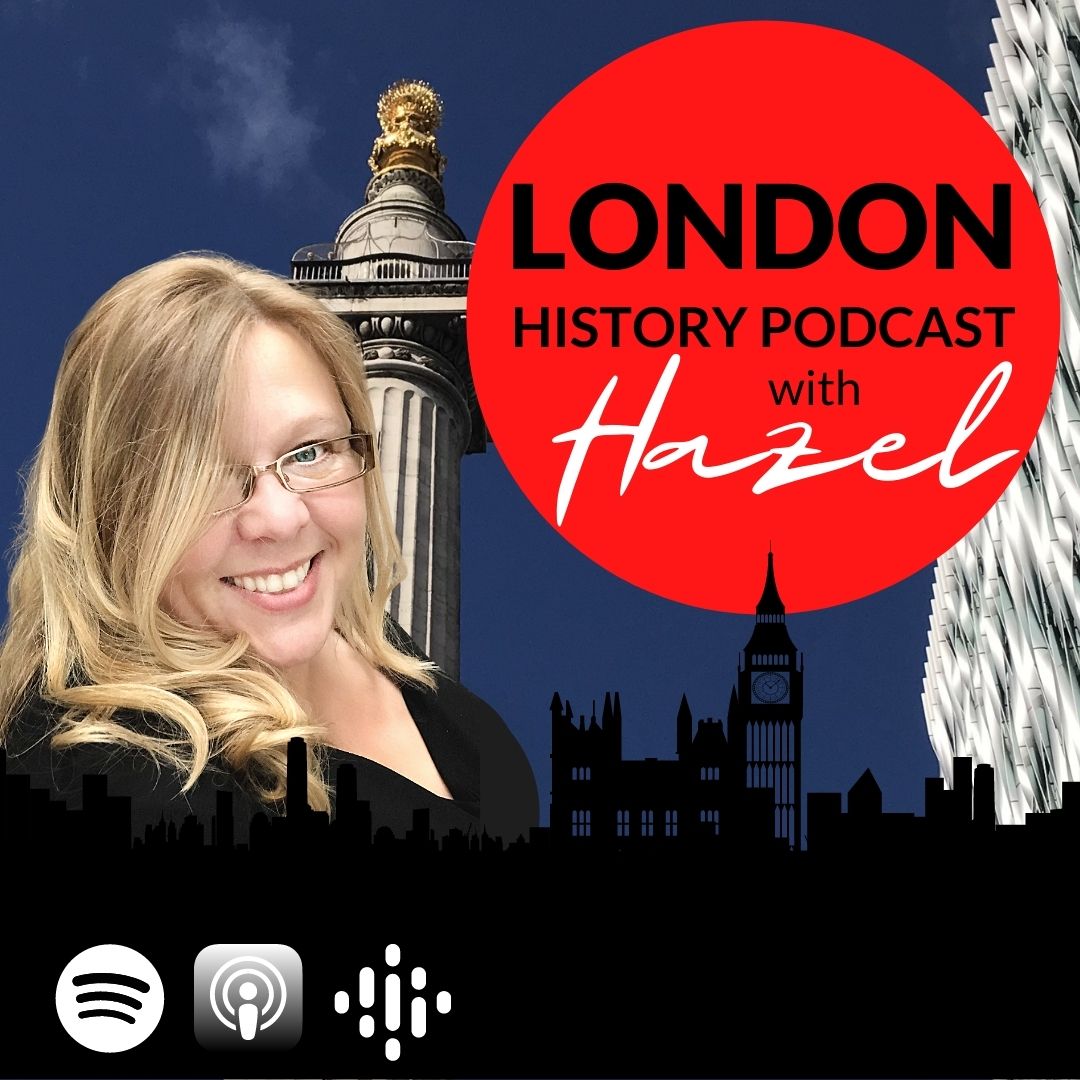
 Hazel:
Hazel: 
